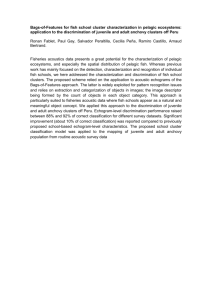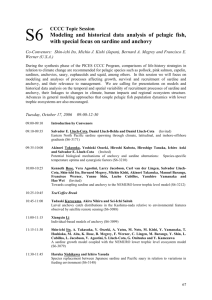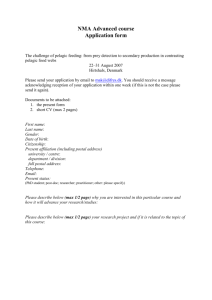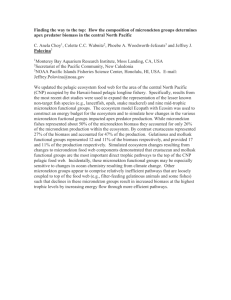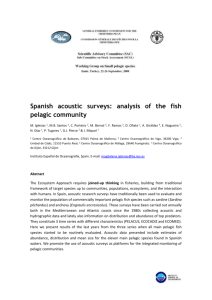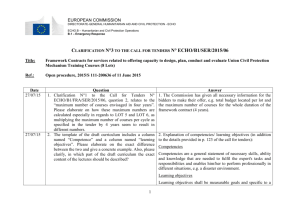MEDIAS Meeting report - STECF
advertisement
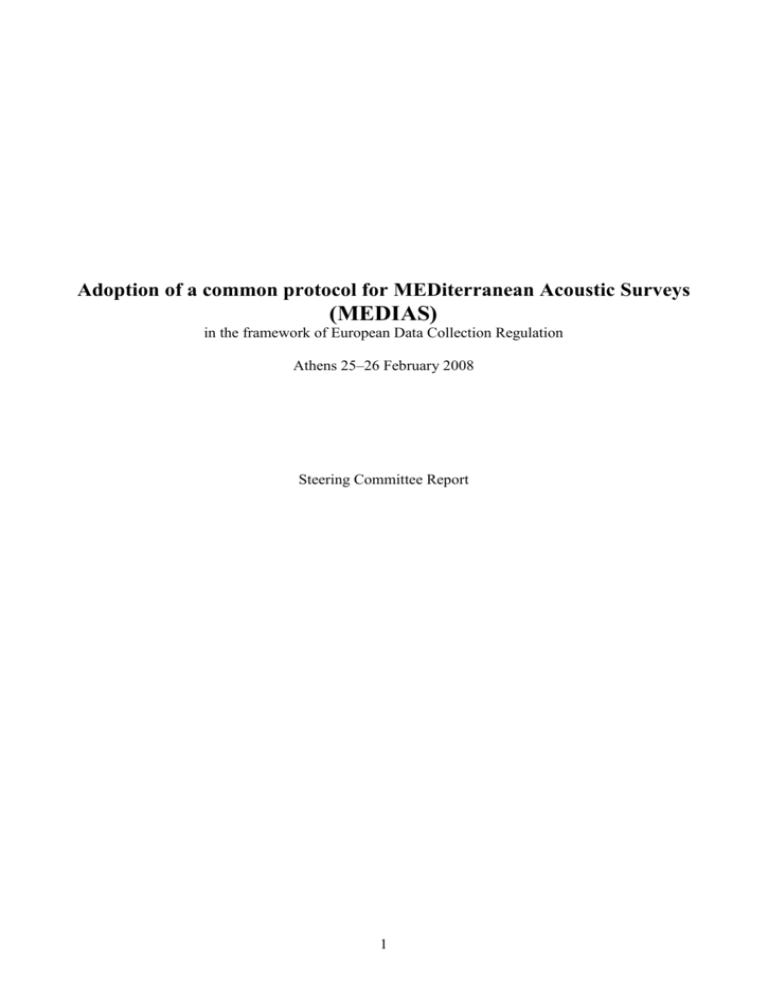
Adoption of a common protocol for MEDiterranean Acoustic Surveys (MEDIAS) in the framework of European Data Collection Regulation Athens 25–26 February 2008 Steering Committee Report 1 The current workshop took place in Athens between 25 and 26 /2/2008 following the establishment of a MEDIAS Steering Committee in the Regional Coordination Meeting (RCM) for the Mediterranean held in Cyprus in May 2007. The aim of the workshop was to adopt a common Protocol for a Pan-Mediterranean Pelagic survey (MEDIAS) within the framework of the DCR, according to the recommendation of the RCM and the decision of the Liaison Meeting. Participants in the meeting were representatives from all European Union countries involved in acoustic surveys in the Mediterranean (i.e. Greece, Italy, Slovenia, Malta, France and Spain) and the facilitator for the Working Group on Small Pelagic Species (Sub-Committee for Stock Assessment) of the GFCM (See list of participants ANNEX I). During the first day of the meeting, after the welcome to participants by the Director of the Institute of Marine Biological Resources of the Hellenic Centre for Marine Research, Dr. C. Papaconstantinou, the participants adopted the agenda of the Workshop. (See agenda of the meeting ANNEX II) Dr. Antonio Cervantes from the Directorate General for Fisheries and Maritime Affairs presented the background and the status of the Pan-Mediterranean Pelagic Survey concerning the recommendations of the two Regional Coordination Meetings for the Mediterranean (held in Malta and Cyprus), the decisions of the Liaison Meeting and the suggestions of the SGRN of STECF regarding the incorporation of the Pan-Mediterranean Pelagic Survey in the new Data Collection Regulation. At the beginning of the discussion, the description of the methodology followed in each area up to now was presented and the different protocols were discussed in a comparative way, in order to highlight the similarities and differences among them. During this session, a first discussion on the harmonization of the different protocols has been done. The methodology and protocols for each survey is presented in the following Table 1. Table 1. Acoustic parameters used by the Institutions in the surveys in the Mediterranean. Parameter Gulf of Lions (IFREMER) Aegean Sea (HCMR) Adriatic Sea (ISMAR – FRIS) Sicilian channel (IAMCMCFS) Iberian coast (IEO) Survey Identity Country France Greece Italy & Malta Spain Geographic area Gulf of Lions northern Aegean Sea G.S.A. 16 (1998-2007) G.S.A 15 (2004-2007) Spanish Mediterranean Sea (continental shelf) Area covered 3 300 NM2 9 000 NM2 2 700 NM2 8 829 NM2 Days at sea Indicative available time series of acoustic surveys Vessel 20 Since 1995 40 Since 1995 with gaps Italy & Slovenia Western part of the Adriatic Sea and Slovenia waters (in 2001 and 2007) Italy: 15 000 NM2 Slovenia: 117 NM2 40 + 1 Since 1976 10 Since 1998 31 Since 1993 RV “L’EUROPE RV “PHILIA” RV “Dallaporta” RV “Dallaporta” RV “CORNIDE DE SAAVEDRA” 2 Parameter Gulf of Lions (IFREMER) Aegean Sea (HCMR) Adriatic Sea (ISMAR – FRIS) Sicilian channel (IAMCMCFS) Iberian coast (IEO) July June June to September June to September Transects design perpendicular to bathymetry 12 Zig-zag transects alternately parallel 10 perpendicular to bathymetry Inter-transect distance (NM) Time of day in which acoustic data are collected EDSU (nm) Bottom depth (min, m) Echo sounding depth (min, m) Echo sounding depth (max, m) Fishing gear Target species perpendicular to bathymetry Zig-zag inside the gulfs 10 November and December, anchovy recruitment period in the area perpendicular to the coast Daytime Daytime Fulltime Full time 8 in wide continental shelf; 4 in narrow shelf Daytime. 1 15 1 10 1 10 1 10 1 30 5 5 7 7 5 400 230 250 300 200-220 Pelagic trawl Anchovy and Sardine Pelagic trawl Anchovy and Sardine Pelagic trawl Anchovy and Sardine Pelagic trawl Anchovy and Sardine Other species All pelagics Horse mackerel, mackerel, gilt sardine Pelagic trawl Anchovy, sardine and sprat Horse mackerel, chub mackerel, gilt sardine, etc. Mackerel, Sardinella Horse mackerel Horse mackerel, chub mackerel, gilt sardine, bogue EK500 puis ER 60 Biosonic DTX Simrad EK500 Simrad EK60 38 38 38 38 Simrad EK60 since 2006. Previous years Simrad EK500 38 120, 120 120, 200 120, 200 1.0 0.5 1, 1, 0.6 1 18,70,120,200 (since 2006) 1 -80 -80 -70 -60 -70 -70 No limit with the raw data -60 No limit with the raw data -60 1 per survey 1 or 2 per survey 1 per survey 1 per survey 1 per survey -71.0 -71.2 -72.6 -71.2 -72.5 -74.6 -70.51 -75.3 -72.6 -72.6 -71.2 -71.2 -68.7 -84.9 Survey design Month/Period of the year that the survey take place Echo sounder parameters Echo sounder Frequency for assessment (kHz) Complementary frequencies (kHz) Pulse duration (ms) Threshold for acquisition (db) Threshold for assessment (db) Calibration (No per survey) Applied TS (db) [20Log L(cm)] Sardine Anchovy 20Log L(cm) Horse mackerel Mackerel Sprat Spanish Mackerel Blue whiting -68.7 -70 -71.2 -70 -71.7 4-8 - 3 Parameter Mackerel (S. japonicus) Bogue Sardinella Abundance estimates Software for analysis Gulf of Lions (IFREMER) Aegean Sea (HCMR) Adriatic Sea (ISMAR – FRIS) -71.2 -71.2 SonarData Echoview File format *.hac *.ev, *.hac Inter - transect Acoustic energy in the intertransect track not taken into account Acoustic energy in the inter-transect track not taken into account Echo partitioning into species Echo trace classification based on echogram visual srcutinisation (Direct allocation by type of structure and allocation on account of representative fishing station) Total and by zone pelagic biomass and biomass per species, Total and by zone pelagic number and number per species, Pelagic biomass and biomass per species,Biomass per mile, Numbers per species per mile Echo trace classification based on echogram visual srcutinisation (Direct allocation and allocation on account of representative fishing station) Fish sampling Codend Vessel speed during fishing Time of day Iberian coast (IEO) -68.7 Movies Abundance indices estimated Sicilian channel (IAMCMCFS) - 67 -72.6 SonarData Echoview, GFRDBS (CNR – ISMAR software) *.hac, *.ev, *.xls, *.txt, *.ek5 Acoustic energy in the inter-transect track not taken into account Frequencies comparison, pelagic trawl, TS analysis when needed SonarData Echoview SonarData Echoview *.hac, *.raw, *.bot, *.idx *.ev, *.hac, *.raw Acoustic energy in the inter-transect track not taken into account Visual analysis of echogram and from results of control trawl Acoustic energy in the inter-transect track not taken into account NASC per EDSU: Total & per species Total biomass Biomass per mile Biomass per species Number per species Numbers/species/age Biomass/species/age Total pelagic biomass and biomass per species (possible NASC per EDSU, total pelagic biomass per mile) NASC per ESDU, Total Biomass, Biomass per age NASC per EDSU, Numbers per age, Biomass per age 12 mm 8 mm 9 mm of mesh side; 18 mm of mesh size 3.5-4.5 kn 3.5-4 kn 3.5-4 kn 9 mm of mesh side; 18mm of mesh size 3.5-4 kn 3.5-4 kn Daytime Daytime / night time Daytime/night time Daytime / night time Daytime for echo traces identification / night time 4 Allocation on account of representative fishing station Parameter Gulf of Lions (IFREMER) Aegean Sea (HCMR) Adriatic Sea (ISMAR – FRIS) Sicilian channel (IAMCMCFS) Iberian coast (IEO) 17-37 20-37 40-50 20-25 for evaluation (when the species are dispersed near the surface). 50-70 as many as possible, when echo traces are visible, to ensure identification of echo traces obtain length structure of the population obtain species composition get biological samples as many as possible, when echo traces are visible, to ensure identification of echo traces obtain length structure of the population obtain species composition get biological samples as many as possible, when echo traces are visible, to ensure identification of echo traces obtain length structure of the population obtain species composition check lengthweight equation Depending on bottom type and time of day, as many as possible (generally 4 per day), targeting an uniform distribution as many as possible, when echo traces are visible, to ensure identification of echo traces obtain length structure of the population obtain species composition check length-weight equation Total length or Fork length for Scomber spp Total weight by length classes Age in recent years for anchovy and sardine Total length Total weight Eviscerated weight Gonad weight Stage of maturity Age Total length Total weight Sex Stage of maturity Age Total length Total weight Sex Stage of maturity Age Oceanographic Parameters taken in stations: CTDs CTD:T, S, CTD: T, S, Fluor., par, plankton CTD: T, S, Fluor., turbidity, oxygen Basic: individual Total Length, Total Weight by length classes Other: Eviscerated weight, Gonad weight, Stage of maturity, Age CTD: T, S, Fluor., par, plankton Oceanographic. Parameters taken continuously T, S, (birds and mammals opportunistic) mammals No of hauls (minmax) Sampling intensity Biological and environmental parameters Fish measurements CTD:T, S, T, S, CUFES, Birds According to the SGRN recommendation (‘Direct surveys’ meeting, 12-16/2 2007, Brussels), each one of the surveys included in the Pan-Mediterranean survey should give information for management decisions, providing input to assessment of stocks which are managed internationally. Each survey should provide: i. Information on important age groups 5 ii. Information on biological parameters iii. Information on trends In a next step the working group agreed on the issues to discuss in the framework of the protocol of the Pan-Mediterranean acoustic survey concerning the acoustic methodology, the biological parameters collected in each survey and the reporting of the data. The working group discussed issue by issue and agreed on the common protocol that will be followed in the MEDIAS survey. During the discussion the participants from IFREMER presented conclusions adopted by the coordinated survey for anchovy in the Atlantic (Bay of Biscay). So, the protocol of the respective survey in the Bay of Biscay, was taken into consideration in order to facilitate future collaboration between the two surveys. The participants concluded that in this first approach for the harmonization of the acoustic surveys, in order to form and adopt a common protocol, the WG had to consider that: a) each survey covers geographical areas with different sizes (see Table 2), b) each country uses different research vessels and equipments and c) the surveys are highly dependant on research vessel availability. All these can cause differsification in certain aspects of the methodology among areas which are not expected to affect the requirements of the survey and the comparability of the results. The workshop participants agreed the following: 1) Survey Identity. The geographical areas that will be covered by MEDIAS and the days at sea are presented in Table 2. Table 2. The size of the geographical area that will covered by each Institute. Country Institute Greece France Slovenia HCMR IFREMER FRIS Italy Italy - Malta Spain CNR-ISMAR CNR- IAMC IEO Geographical area Aegean Sea Gulf of Lions Adriatic Sea (Slovenia) Adriatic Sea (Italy) Sicily channel Iberian coast 9 000 NM2 3 300 NM2 117 NM2 Duration of survey (days) 40 20 1 15 000 NM2 2 700 NM2 8 829 NM2 40 12 31 Size of area In the report to the DCR, the geographical area, the size of the area and the days at sea, as well as the vessel characteristics should be reported by each country. Survey timing was defined after a detailed discussion taking into account: 1) The geographical boundaries of different stocks. It is known that three genetically different, major anchovy stocks exist in the Mediterranean: the north-western Mediterranean stock (mainly shared between Spain and France), the Adriatic Sea stock (mainly shared between Italy, Slovenia and Croatia) and the Aegean Sea stock; 2) The existing time series of data in each area. The historical time series are of great importance because the temporal (interannual) trend in biomass estimates is useful in assessment and the setting of reference points. Any revision on the methodology and the estimation procedures should go back and revise the past estimates. 3) The target of the survey according to the priorities that have been set by each country. Surveys that are being held during the 2nd -3rd quarter of the year are targeting the spawning stock of anchovy and surveys that are being held during the 4th quarter are targeting the anchovy recruitment. Based on these it has been agreed that: 6 A) The MEDIAS will cover the major anchovy stocks during the spawning period (June to September, 2nd -3rd quarter). B) The spawning stock of the shared anchovy stock in the north western Mediterranean will be fully covered by a southern extension of the Gulf of Lions survey in summer. C) The valuable time series of the Spanish recruitment survey should be continued. 2) Echo sounder parameters. In all areas a split beam echo–sounder will be used for the echo–sampling. The angle beam of the echo–sounder will be reported. The frequency that will be used for assessment was agreed to be the 38 kHz, while complementary frequencies will be the 120 and/or 200 kHz, depending on the research vessel used. The pulse duration will be 1 ms, the threshold for data acquisition will be at 80 dB and the ping rate will be set as fast as possible depending on depth, in order to assure good echo discrimination. A detailed discussion took place, regarding the number of calibrations per survey, based also on the experience from the survey in the Bay of Biscay. It was agreed that one calibration of echo-sounder will be held per survey based on the procedure described in the manual of each echosounder and by Foote et al. (1987). The workshop discussed and concluded on a number of calibration parameters and results that should be included as a minimum in the survey report. These are tabulated in Annex III. 3) Survey Design. The working group discussed in detail the sampling design followed in each region taking into account the peculiarities in the topography of each area. It was agreed that two aspects should be considered in choosing the direction and the type of transects (i.e. parallel or zig zag). Transects preferably run perpendicular to the greatest gradients in fish density, which is often related to gradients in bottom topography, meaning that transects will normally run perpendicular to the coastline/bathymetry. In cases that topography is complex like in the case of semi-closed gulfs transect design could be decided otherwise. The survey design in each area should be reported. The inter-transect distance should not exceed 12 NM based on preliminary studies of the spatial structure characteristics of small pelagics in the Mediterranean Sea. Vessel speed during acoustic sampling should be adjusted depending on vessel noise as set by the ICES-WGFAST (WGFAST 2006). The working group agreed that vessel speed of 8-10 knots in adequate for a split beam echo sounder of 38kHz. At higher speeds, problems might encounter with engine noise or propeller cavitations. The noise of the vessel in different speeds should be reported. It was strongly recommended that if species identification depends on recognition of schools on the echogram the survey will have to take place only during day-time, being interrupted during periods in the 24-hour cycle when the schools disperse. Otherwise, if available survey time does not permit this, echo sampling might be extended. In this case, echo allocation into species will not be based on school shape identification and justification should be given in the report that this does not affect the accuracy of the estimations The working group agreed that transects should be extended as close to the coast as possible in order to obtain the best estimation for sardine. Because each survey uses research vessel of different size that sets a limit to the minimum distance from shore, it was suggested that acoustic sampling should be held at least from 20 m bottom depth, or less if possible. In each case the minimum bottom depth of each survey should be reported. The maximum echo-sounding depth should be 200 7 m and the minimum echo-sounding depth should be reported as it depends on the draught of the research vessel. The working group decided that a workshop should be held in the framework of MEDIAS focusing on: The optimization of survey design. In this workshop, existing survey designs will be reviewed, area peculiarities (e.g. size of the area, topography, survey duration) will be taken into account and results from a geostatistical analysis applied to historic acoustic data from different areas in the Mediterranean Sea will be evaluated for survey design optimization, taking into account the spatial characteristics of small pelagic fish aggregations. 4) Acoustic methodology The Elementary Distance Sampling Unit (EDSU) for echo integration will be 1 NM. The acoustic energy in the inter-transect tracks will not be taken into account. The working group agreed that for compatibility reasons all the data will be saved with a threshold for acquisition at -80 dB. As the main objective is the optimum discrimination between fish and plankton, the threshold for assessment was set at -70 to -60 dB, depending a) on noise level (-60 dB in case of high noise) b) the peculiarities of each area regarding school morphology and plankton density (-60 when plankton is dense, but -70 dB when small schools dominate the area) c) echo-sounder features d) whether echo integration is based on school echo integration (-70 dB) or stratum integration (-60 dB) and e) time of day that echo acquisition is carried out. The working group concluded that the target species of the survey will be anchovy (Engraulis encrasicolus) and sardine (Sardina pilchardus). The echo partitioning into species will be based on echogram visual scrutinisation. This will be done either by direct allocation based on the identification of individual schools and/or allocation on account of representative fishing stations. Regarding the Target Strength (TS) equation that should be applied in each species, a detailed discussion took place among the working group participants. The possibility to apply in MEDIAS the target strength used for anchovy and sardine in the Bay of Biscay for compatibility reasons has been discussed. Dr. J. Masse informed the participants that the target strength used in the Bay of Biscay is currently under revision and no common target strength equation is applied. Furthermore, according to the biological background of target strength and other recent scientific findings, the target strength is likely to vary among stocks, areas and seasons. In the Mediterranean school characteristics vary largely among areas and the working group concluded to maintain, for the time being, the historical Target Strength equations used in each area for the target species. In each case, the TS equation applied should be reported. The application of new TS equations in the Mediterranean, common for all areas, would require the revision of the past estimates of the existing time series which would require time and effort. Such common TS equations must derive from in situ estimations of TS, preferably based on acoustic data from the Mediterranean Sea. 8 For this purpose the working group decided that a workshop should be held in the framework of DCR and MEDIAS coordination meetings on: “Harmonisation and optimisation of acoustic methodology”. In such a workshop issues regarding the estimations of common TS equations for each target species would be decided taken into consideration a) literature information and b) the application of different TS equations to existing raw acoustic data and the subsequent comparison of the results. Furthermore, all participants agreed to collect additional appropriate data during the 2008 survey for in situ TS estimations in each area. Regarding acoustic data processing for the assessment of the target species, the use of Movies and / or Echoview software for the analysis and estimation of abundance has been agreed. For compatibility reasons, all data should be available into a common *.hac file format. Raw data will be stored within the responsibility of each country. The common *hac format will be also available for the requirements of the Data Collection Regulation (DCR). 5) Abundance indices. Regarding stock assessment and the abundance indices that will be estimated and reported in the DCR within the framework of MEDIAS, the following have been agreed: The target species of MEDIAS for assessment purposes will be anchovy (Engraulis encrasicolus) and sardine (Sardina pilchardus). For these two species, abundance estimates should be provided in the report. In addition, abundance indices could be given for all pelagic species in the community which are important in each area. Regarding these non–target species, Length– Weight relationships and Length frequency distributions will be provided. The abundance indices that will be estimated by all MEDIAS participants and will be provided in the DCR report should include both NASC (independent from TS equations) and Biomass estimations and are listed below : 1. Total fish NASC per EDSU 2. Target Species NASC per EDSU 3. Biomass per EDSU per target species 4. Numbers per EDSU per target species 5. Number/age/Target species 6. Biomass/age/Target species In addition it has been agreed that in the report for the DCR the following items will also be provided: 1. Point maps of total fish NASC 2. Point maps of target species in NASC/mile; biomass/mile. 3. Catch compositions of the hauls: pie-charts indicating biomass per species Furthermore, the need for a common database has been discussed. The fields of a common acoustic database will be established by the MEDIAS participants in future meetings. The need for collaboration with respective surveys in the Atlantic (bay of Biscay) has also been discussed and agreed. In the framework of this collaboration, information and experience will be exchanged. According to the standard methodology followed in acoustics, species allocation of the acoustic records is impossible if no trawl information is available. Fish sampling is required to collect representative samples of the fish population in order to identify echoes. The main objectives of trawling in an acoustic survey are a) to obtain a sample from the school or the layer that appears as an echo trace on the sounder for echo trace identification and allocation into species and b) to get biological information and evaluation of the size distribution of each species. Therefore, the 9 trawling gear used is of no importance as long as it is suitable to catch a representative sample of the target-school or layer. In addition, the sampling intensity can not be pre-determined because of the objectives of the acoustic survey per se. The sampling intensity in an acoustic survey depends on the size of the area covered, the frequency of occurrence of different echo traces in the sounder and the spatial characteristics of fish aggregations. In addition, the geographical coordinates or the sampling depth of the hauls can not be pre-determined because pelagic species execute extended horizontal and vertical movements. Characteristics of schools might change depending on the area, the time period or even the fishing pressure. Therefore, the sampling strategy has to be adaptive depending on the school characteristics per area, time period and year. Taking into account, in the framework of a common protocol, the different research vessels used and the peculiarities of each area the following points have been agreed: A pelagic trawl will be used in all areas for sampling, Maximum codend mesh size should be equal to 24 mm (side of mesh equal to 12 mm). The codend and trawl characteristics used in each area will be reported. The duration of hauls should be no less than 30 min for unknown echoes and when multispecies, scattered echoes are being fished. Vessel speed during fishing should be 3.5–4.5 knots The total number of hauls must be adequate in order to a) ensure identification of echo traces; b) obtain a representative length structure of the population for each target species; c) obtain species composition and biological samples. It was agreed that the following biological and oceanographic parameters will be collected: 1) Since the environmental parameters are very important for small pelagic fish, a minimum of 3 CTD stations should be held per transect or over a grid of stations with density adequate to describe the oceanography of the surveyed area. The minimum set of parameters that should be measured in the water column will be temperature and salinity. 2) Regarding the biological parameters, the composition of the pelagic community should be reported as Biomass per species and Number per species for each haul. In addition, the Length frequency distribution (0.5 cm) should be estimated from a representative sample for each species per haul. Total length will be measured for all species. The size of each sample should be at minimum that described in the respective protocol of the Data Collection Regulation (DCR). It was also agreed that the Length– Weight relationship for all species will be estimated and reported. Furthermore, a representative Age Length Key (ALK) that will be used for the conversion of abundance indices to abundance-at-age should be obtained for the target species, anchovy and sardine. The mean length-at-age will also be estimated and reported. Table 3. Summary of the common protocol for the Pan-MEditerranean Acoustic Survey (MEDIAS). Survey Identity Geographic area Size of Area covered Days at sea Vessel Period of survey Should be reported Should be reported Should be reported Should be reported A) The survey will cover the major anchovy stocks during the spawning period (summer) B) The spawning stock of the shared anchovy stock in the north western Mediterranean will be fully covered by a southern extension of the Gulf of 10 Lions survey in summer. C) The valuable time series of the Spanish anchovy recruitment survey should be continued. Echo sounder parameters Echo sounder Frequency for assessment (kHz) Complementary frequencies (kHz) Pulse duration (ms) Beam Angle Ping rate Calibration (No per survey) Threshold for acquisition (dB) Threshold for assessment (dB) Survey design Transects design Inter-transect distance (NM) Time of day for acoustic sampling EDSU (nm) Distance from the coast according to the Bottom depth (min, m) Echo sounding depth (min, m) Echo sounding depth (max, m) recording. Vessel speed Software for analysis File format Inter - transect Applied TS (dB) Echo partitioning into species Abundance estimates Abundance indices estimated Maps and charts Common database Fish sampling Target species Other species Fishing gear Duration of haul Vessel speed during fishing Sampling intensity, no of hauls Split beam 38 120, 200 depending on availability. 1 ms Should be reported Maximum depending on depth A calibration report should be given (Annex III) One calibration per survey -80 -70 to -60 (reported) Perpendicular to the coastline/bathymetry, otherwise depending on topography The survey design should be reported. Max <=12 NM. Day time. Otherwise, in cases of time limitation and if echo allocation into species does not depend on school shape identification (in this case justification of the accuracy of results will be presented) 1 NM At least 20 m bottom depth, minimum 10 m of echo-sampling. Depending on the draught of RV. Should be reported 200 m 8-10 knots Movies and/or Echoview *.hac Acoustic energy in the inter-transect track will not be taken into account Keep historical TS equations. Echo trace classification based on echogram visual scrutinisation Direct allocation and allocation on account of representative fishing station Total fish NASC per EDSU Target Species NASC per EDSU Biomass per EDSU per target species Numbers per EDSU per target species Number/age/Target species Biomass/age/Target species Point maps of total fish NASC Point maps of target species in NASC/mile; biomass / mile. Catch compositions of the hauls, pie-charts indicating biomass per species Issues of common database will be established by the participants Discussed the possibility to collaborate with the Atlantic survey Anchovy, Sardine Biological data for all species in the pelagic community: Length-Weight relationships; Length distribution. Pelagic trawl, Codend and trawl characteristics should be reported. Max Codend mesh size = 24 mm (side of mesh = 12 mm). Minimum 30 min for unknown echoes 3.5 – 4.5 knots The total number of hauls has to be adequate to 11 Biological and oceanographic parameters Length Age readings, ALK Length - Weight Oceanographic. Parameter (CTD) ensure identification of echo traces obtain length structure of the population obtain species composition get biological samples All species: Total length (TL), Length frequency distribution (0.5 cm) Sardine, Anchovy: Mean TL at age Sample sizes according to the new DCR. All pelagic species Minimum 3 CTD per transect or grid of stations with density adequate to describe the oceanography of the area. Minimum variables: T, S 12 ANNEX I List of participants Name Athanassios Machias Marianna Giannoulaki Konstantinos Tsagarakis Bernard Liorzou Jacques Masse Mark Dimech Tomaz Modic Andrea De Felice Iole Leonori Angelo Bonanno Dolores Onate Magdalena Iglesias Antonio Cervantes Stylianos Somarakis e-mail amachias@ath.hcmr.gr marianna@her.hcmr.gr kontsag@her.hcmr.gr bliorzou@ifremer.fr jmasse@ifremer.fr mark.dimech@gov.mt tomaz.modic@zzrs.si a.defelice@ismar.cnr.it i.leonori@ismar.cnr.it angelo.bonanno@iamc.cnr.it Dolores.onate@be.ieo.es Magdalena.inglesias@be.ieo.es antonio.cervantes@ec.europa.eu somarak@her.hcmr.gr Country Greece Greece Greece France France Malta Slovenia Italy Italy Italy Spain Spain 13 HCMR HCMR HCMR IFREMER IFREMER MCFS FRIS CNR-ISMAR CNR-ISMAR CNR- IAMC IEO IEO EC–DG Fish and Maritime Affairs Facilitator of the WG on Small pelagics (GFCM) ANNEX II Agenda of the MEDIAS meeting Adoption of a common protocol for Mediterranean Acoustic Surveys in the framework of European Data Collection Regulation Athens 25–26 February 2008 Monday 25/2/2008 9:00 - 9:20: Welcome of the participants. Definition of the agenda. 9:20 – 10:50: Presentation by Dr. Antonio Cervantes of the background and status of the PanMediterranean Research Survey. 9:50 – 10:00: Questions - discussion 10:00 - 10:20: Presentation of the protocols followed by each survey up to now (Table I). 10:20 – 11:00: Presentation of the protocols followed by each survey up to now (Table I). Definition of the list of issues that should be discussed and included in the common protocol. 11:00 – 11:20: Coffee break 11:20 – 13:00: Definition of the list of issues that should be discussed and included in the common protocol. (Continued from previous) 13:00 – 15:00: Lunch break 15:00 – 16:30: Discussion on the common protocol 16:30-16:50: Coffee break 16:50 – 19:00: Discussion on the common protocol (Continued from previous) Tuesday 26/2/2008 9:00 – 11:00: Discussion and conclusion on the common protocol(Continued from previous) 11:00 – 11:30: Coffee break 11:30 – 13:00: Discussion and conclusion on the common protocol 13:00 – 15:00: Lunch break 15:00 – 16:30: Adoption of the report 16:30-16:50: Coffee break 16:50 - 18:00 Adoption of the report 18:00 End of meeting 14 ANNEX III Calibration report Calibration report Frequency (kHz) Echosounder type Transducer serial no. Vessel Date Place Latitude Longitude Bottom depth (m) Temperature (oC) at sphere depth Salinity (psu) at sphere depth Speed of sound (ms-1) TS of sphere (dB) Pulse duration (s) Equivalent 2-way beam angle (dB) Receiver delay (s) Default Sv transducer gain Iteration no. Time Range to half peak amplitude (m) Range to sphere (m) Theoretical NASC (m2 nm-2) Measured NASC (m2 nm-2) Calibrated Sv transducer gain Delta G=New gain-Old gain Correction factor for precalibration NASCs on EK Correction factor for precalibration Sv’s Default TS transducer gain Time Measured TS Calibrated TS gain 15
